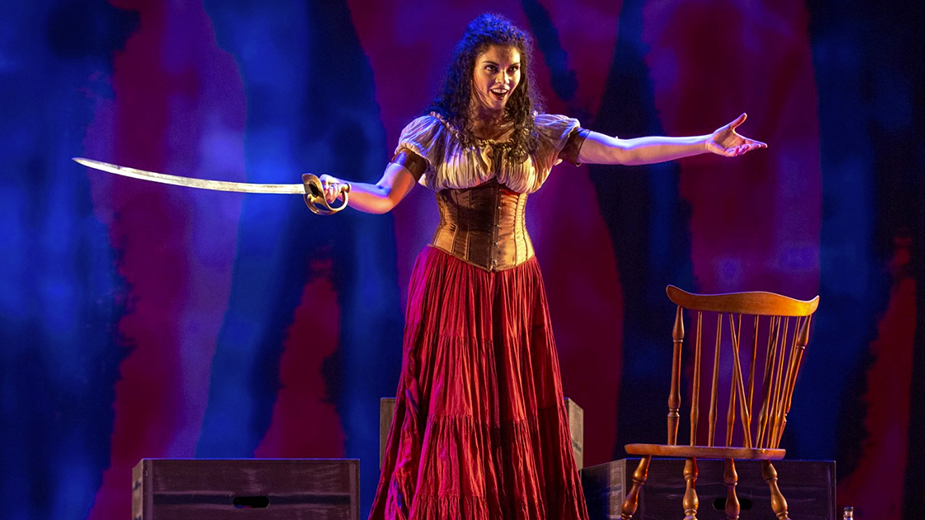YOUNGSTOWN, Ohio – Opera Western Reserve’s upcoming production of “Carmen” could prove to be a turning point for the company.
It will mark the first time OWR stages a performance in Powers Auditorium, which will allow for a better theatrical experience for the audience.
“Carmen” will be performed Nov. 17 at 7:30 p.m.
All previous OWR operas took place in Stambaugh Auditorium, where the company has been headquartered since it was launched in 2004.
Scott Skiba, director of “Carmen,” is excited about the move. In addition to allowing him to make performances with more visual pizzazz, he says it will remove the many physical obstacles the cast and creative team had to overcome at the former location.
“Stambaugh Auditorium is beautiful and a wonderful concert hall,” Skiba says. “But it is a concert hall. It was built for live music concerts.”
That means that – unlike Powers – it has no orchestra pit, no wings on either side of the stage, no backstage dressing rooms, and no fly system that moves scenery and screens on and off stage instantly.
Powers Auditorium has all of these trappings of a theater built for musicals.
An opera production typically involves dozens of actors, large and elaborate set pieces and platforms and an orchestra. At Stambaugh, that meant a logjam of bodies squeezing around each other backstage, and an orchestra on the floor in front of the stage that reduced the number of premium seats that could be sold.
PROBLEM-SOLVING
It also added another layer of work to the creative team.
“We spent most of our time problem-solving rather than maximizing the impact of the show on the audience,” Skiba says. “We have so many choristers [in ‘Carmen’] that they wouldn’t even fit backstage at Stambaugh this year.”
The cast of “Carmen” includes 20 children, including a chorus of singers from Smarts, led by Austintown Middle School music teacher Megan Keown; 20 adults, including dancers from Ballet Western; and the principal artists.
“It was always a creative sleight of hand in how to get everyone on and off stage, and where they would wait backstage and change costumes,” Skiba said.
Woefully inadequate for opera performances, Stambaugh’s renowned acoustics were also diminished by the building’s limitations.
“It has wonderful acoustics – until you put the orchestra out on the floor,” Skiba said. “With last year’s production of ‘La Boheme,’ we had some large voices but there were balance issues because of that.”
At Powers, Skiba says, all performers and musicians will be more comfortable, and not “elbow to elbow.”
The physical improvements will also be obvious to the audience. The best seats will be closer to the stage and sightlines will be better.
Says Skiba, “The overall impact will be elevated. Producing theater in a theater makes life easier.”
Powers Auditorium’s orchestra pit got a shakedown last year when Ballet Western Reserve used it for its production of “The Nutcracker.” It was the first time in decades that the orchestra pit was used.
“It worked,” Skiba says.
If OWR has a similar success with “Carmen,” it will build on it and make next year’s performance a little grander, Skiba says. And if unseen problems arise, productions can always move back to Stambaugh, he notes.
Susan Davenny Wyner, music director of OWR, concurs that this year’s show will markedly improve the audience experience.
“This performance in Powers is going to be a whole new adventure,” she says. “And with the orchestra in the pit, it allows the values of the production on stage to be much more elaborate and theatrical, which should be very exciting.”
THE STORY
The opera “Carmen” tells the tragic love story between a soldier, Don Jose, and Carmen, a fiery and beautiful factory worker.
It was written by French composer Georges Bizet and premiered in 1875 in Paris.
Opera Western Reserve produced “Carmen” twice before, in 2009 and 2016.
The cast of the current production features Paulina Villareal in the title role, and Jonathan Kaufman as Don Jose. Marian Vogel is Micaela, Andre Chian is Escamillo, Hayley Abramowitz is Frasquita, Melanie Ashkar is Meredes, Samuel Jungman is Le Remendado, Alex Lindenmeier is Le Cancaire, Jason Budd is Zuniga and Brian Keith Johnson is Morales.
The stage will be dominated by a huge platform that will be sloped downstage. On it will be the emblem of the ace of spades – a motif that symbolizes the fates, Skiba says.
The fly system, which raises props and screens vertically offstage into the loft above the stage, will only be utilized for a projection screen. “The main thing is making sure we can establish a solid acoustical environment,” Skiba says. “[In the future] we will learn what we can do [with the fly system] based off of that.”
The acoustic panels above the stage will be raised and lowered to improve sound. Scenery will be in the form of projections on a screen that will extend the width of the back of the stage, Skiba says.
Tickets for “Carmen” range from $75 to $25 (plus fees) and can be purchased at OperaWesternReserve.org; by phone at 330 259 9651; and in person at the DeYor Performing Arts Centre box office, downtown.
Pictured at top: Brennan Martinez portrays the title character in a 2019 production of “Carmen” in Hawaii that was directed by Scott Skiba. A Nov. 17 production of “Carmen” by Opera Western Reserve in Youngstown, also directed by Skiba, will use the same costuming and lighting. But Skiba says the OWR production will be “200% bigger.” Paulina Villareal will portray Carmen in the OWR production. (Photo by Steve Roby)
